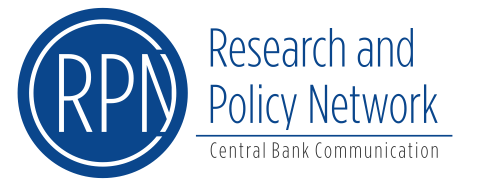
I direct, with Christine Graeff (Director General Communications at the European Central Bank), the CEPR's Research Policy Network on Central Bank Communication.
The last 25 years has seen central banks around the world increasingly use public communication to support their policy goals. Blinder et al. (2008) define central bank communication broadly as the information that the central bank makes available about its current and future policy objectives, the current economic outlook, and the likely path for future monetary policy decisions. Most central banks communicate through statements and minutes related to their decisions, as well as other channels such as speeches, regular reports and testimony to political committees. And when nominal interest rates hit their effective lower bound in the midst of the global financial crisis, communication became a policy tool in its own right, and influential academics (e.g. Blinder 2018) and policymakers (e.g. Draghi 2017) expect it to remain so even as policy rates normalise.
More recently, the substance and style of central bank communication has moved centre stage in the context of safeguarding central bank independence and legitimacy, against the background of enlarged central bank mandates, and greater public scrutiny and political saliency of central bank actions. Reaching out beyond expert circles and connecting to broader audiences – in particular the general public whose expectations and economic and financial decisions ultimately determine economic outcomes, and whose support is crucial for the legitimacy and degrees of freedom of central banks’ actions – is becoming a core plank of central bank communication (Haldane 2018; Cœuré, 2018). Equally, the notion of central bank communication as a two-way process, involving genuine listening and engagement with different audiences, rather than simply one-way broadcasting of central bank announcements is growing in importance (see Haldane 2018, Powell, 2018). As new communications technologies increasingly disintermediate traditional media, and also allow for new ways of interaction, a deeper understanding of the entire communications process - from the central bank at the sending end, the intermediation and interpretation of central bank messages via markets, media, analysts, politicians, etc., to the perception thereof by the recipients - becomes a crucial input into policy decisions.
This shift from central bank opacity to the transparent environment facing most modern central banks is of paramount importance for both the academic study of central bank policy and its effective deployment. There are important questions regarding the channels of effects of communication and their importance for expectations of different agents in the economy. There are also important gaps in our knowledge of the best way to communicate with different audiences and whether different media or ways of communication are more or less effective. There are complementary theoretical, empirical and experimental approaches to addressing questions across these different areas of the literature on central bank communication. In particular, new approaches and the wealth of previously unavailable data (e.g. online engagement) open up new avenues of academic study. Text-mining, webscraping, and machine learning techniques, as well as advances in econometric modelling of the macroeconomic effects of central bank communications, promise to offer new insights. This RPN aims to link and engage researchers from across fields and using different methodological approaches to address these important questions and connect them, in a two-way dialogue, with the interest and research needs of the community of policy-makers and practitioners in communications.
As part of this, we hold events, publicise and develop research, and I hold office hours for researchers working on the topic. For office hours, please fill in the form at this link.